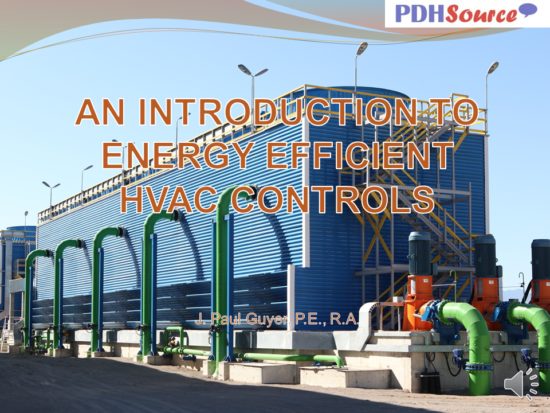E – 1381 Energy Efficient HVAC Controls
$75.00
Courses Included
This course covers automatic temperature and humidity controls, space pressurization controls, safety controls, and energy monitoring and central supervisory control systems for heating, ventilating and air conditioning (HVAC) systems. The control system shall be a complete, reliable, fully functional, maintainable, fully integrated, addressable, control system that has been properly designed, installed, and commissioned. In existing facilities, the design shall be integrated and interfaced into the existing control system so that the new equipment and conditions can be controlled and monitored similar to the existing controlled equipment.
Course Outline
1. GENERAL
2. HUMIDITY CONTROL
3. SIMULTANEOUS HEATING AND COOLNG
4. MECHANICAL VENTILATION CONTROL
5. ENERGY CONSERVATION CONTROL SCHEMES
6. AUTOMATIC CONTROL DAMPERS
7. VARIABLE AIR VOLUME SYSTEM FAN CONTROL
8. FIRE AND SMOKE DETECTION AND PROTECTION CONTROLS
9. GAS-FIRED AIR-HANDLING UNIT CONTROL.
10. COOLING TOWER AND WATER-COOLED CONDENSER SYSTEM CONTROLS
11. CENTRAL CONTROL AND MONITORING SYSTEMS
12. ENERGY METERING
13. DDC HARDWARE REQUIREMENTS
14. DDC SOFTWARE REQUIREMENTS
After completion of this course you will have an understanding of control systems that will allow you to design energy efficient HVAC systems for buildings.
Description
This course covers automatic temperature and humidity controls, space pressurization controls, safety controls, and energy monitoring and central supervisory control systems for heating, ventilating and air conditioning (HVAC) systems. The control system shall be a complete, reliable, fully functional, maintainable, fully integrated, addressable, control system that has been properly designed, installed, and commissioned. In existing facilities, the design shall be integrated and interfaced into the existing control system so that the new equipment and conditions can be controlled and monitored similar to the existing controlled equipment.
Course Outline
1. GENERAL
2. HUMIDITY CONTROL
3. SIMULTANEOUS HEATING AND COOLNG
4. MECHANICAL VENTILATION CONTROL
5. ENERGY CONSERVATION CONTROL SCHEMES
6. AUTOMATIC CONTROL DAMPERS
7. VARIABLE AIR VOLUME SYSTEM FAN CONTROL
8. FIRE AND SMOKE DETECTION AND PROTECTION CONTROLS
9. GAS-FIRED AIR-HANDLING UNIT CONTROL.
10. COOLING TOWER AND WATER-COOLED CONDENSER SYSTEM CONTROLS
11. CENTRAL CONTROL AND MONITORING SYSTEMS
12. ENERGY METERING
13. DDC HARDWARE REQUIREMENTS
14. DDC SOFTWARE REQUIREMENTS
After completion of this course you will have an understanding of control systems that will allow you to design energy efficient HVAC systems for buildings.
- Learn when to apply and not-apply humidity controls;
- Learn what parameters to monitor and control for air handlers;
- Learn about the conditions to be controlled at central HVAC plants;
- Learn about the special control issues with variable-air-volume (VAV) systems;
- Learn the importance of contractor submittals for control systems;
- Learn about the limited situations where simultaneous heating and cooling controls may be allowable;
- Learn about mechanical ventilation controls;
- Learn the fundamentals of energy conservation control schemes; and
- Learn about fire and smoke protection controls on HVAC systems.






